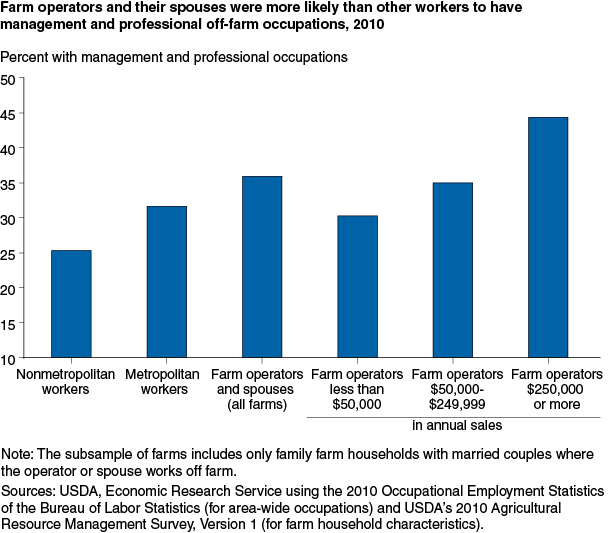When Working Off the Farm, Farm Operators Most Commonly Work in Management and Professional Occupations
- by Jeremy G. Weber and Jason Brown
- 9/3/2013
The median income of U.S. farm households has consistently exceeded the median income of U.S. households in general for the last 15 years. Most farm households earn income from nonfarm sources, and in 2011, roughly 56 percent of their nonfarm income came from off-farm jobs, on average. So, what do farm operators and their spouses do in their off-farm jobs that earns them higher wages?
Little was known about the off-farm occupations of farm household members working off the farm prior to USDA’s 2010 Agricultural Resource Management Survey, which collected information on the topic. The survey used an occupation classification consistent with Bureau of Labor Statistics standards, classifying all off-farm occupations in one of five categories: management and professional; services; sales and office support; natural resources, construction, and maintenance; and production, transportation, and materials moving.
When working off-farm, 36 percent of farm operators and their spouses reported working in management and professional occupations. This share is much higher than that for nonmetropolitan area workers in general (25 percent) and is even higher than that for metropolitan area workers (32 percent). Among farm couples where the operator, spouse, or both reported working off-farm, operators of larger farms and their spouses reported the highest shares of employment in management and professional occupations, suggesting that many of them are able to apply the knowledge and skills used in managing a sizeable farm operation to other areas of employment.
Consistent with the widespread perception that management and professional occupations require the most skill, farm operators and their spouses in these occupations tended to have more formal education than members of other farm households with off-farm employment. Only 17 percent of farm operators who reported high school as their highest educational attainment had a management and professional occupation. In contrast, 56 percent of operators with a college degree or higher had such an occupation. Information on compensation suggests that farm operators working in management and professional positions also tend to receive higher wages than farm operators in other off-farm occupations. Farm operators in management and professional occupations on average received $40 per hour in 2010, $8 more than the next highest paid off-farm occupational group, sales and office support.
The labor economics literature shows that the gap between wages for skilled and unskilled labor in the U.S. labor market has widened over time, particularly in the late 1990s and early 2000s. Looking forward, the evidence that the skills required to operate a successful farm business may also influence off-farm job opportunities suggests that as farm businesses continue to become more complex, the evolving skills and adaptability needed to operate larger farms may continue to bolster the off-farm income prospects of farm households.
This article is drawn from:
- Brown, J. & Weber, J.G. (2013). The Off-Farm Occupations of U.S. Farm Operators and Their Spouses. U.S. Department of Agriculture, Economic Research Service. EIB-117.


